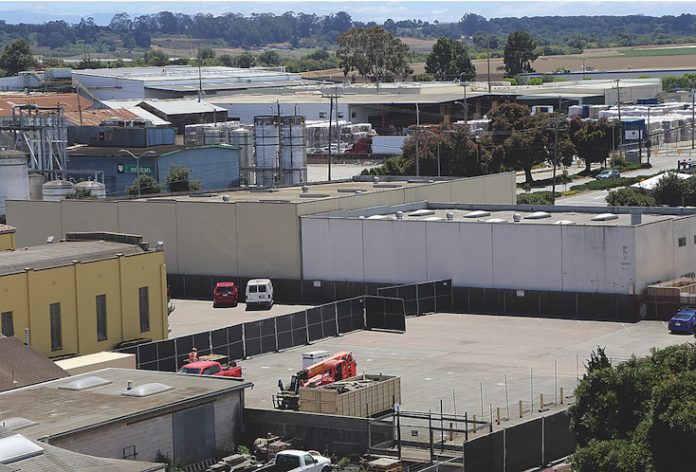Monterey County officials this week broke ground on a “tiny village” project that was delayed for months after neighbors raised concerns and twice appealed to the city of Watsonville.
The 34 small dwellings were intended to give homeless residents living along the Pajaro River a place to live while construction crews rebuild the levee.
But as they prepare for construction to start soon—with a target completion date of late November—officials in Santa Cruz and Monterey counties and several nonprofits are scrambling to find places to move the more than 100 people living in unsanctioned encampments along the levee.
“We’ve got to clean up the river sometime later this summer, and it’s likely to be before the tiny homes are fully ready, and that’s unfortunate,” said Mark Strudley, director of the Pajaro River Flood Management Agency, which is responsible for the levee operation and maintenance. “It’s not the way we wanted it to happen.”
Plans to do a wintertime preemptive cleanup in January fell through when bids for the work came back between $600,000 and $2.2 million, Strudley said.
The agency’s annual maintenance budget, he added, is $2.5 million.
“Even at the lower end we just can’t spend that much money out of our budget to deal with encampments,” he said. “Our budget is really meant to address levee maintenance and channel maintenance.”
The main issue, Strudley said, is that the task of cleaning up from unsanctioned encampments is beyond the purview of a flood management agency’s expertise and experience.
“It’s not something a flood control should or could deal with alone, and that’s going to require that acknowledgement and partnership with both counties and the city, and quite honestly the nonprofit community as well, to help move people out of the river on a permanent basis and to deal with the cleanup itself,” he said.
This includes repairing damage created when people dug shelters into the levee walls, he said.
“It’s actually a risk to the community itself,” he said. “That’s a major structural deficiency to the levee system that protects the community. That’s something we can’t have.”
The project was funded by an $8 million Encampment Resolution Funding grant in 2023 from the State of California.
Management of the 34-unit facility is intended to be a collaboration between Monterey County’s Homelessness Services Program, Santa Cruz County’s Human Services Department and the City of Watsonville.
The project, planned for the parking lot of Westview Presbyterian Church on First Street in Watsonville, has been controversial since it was proposed last year, with neighbors separated from the lot only by a chainlink fence expressing concern how it will affect their quality of life.
It received the final green light in March after a second appeal was denied.
Monterey County Homeless Services Director Roxanne Wilson said that both counties are dedicated to ensuring the project is going to be a benefit to the community.
“We are very excited to see movement after more than a year of going through the process of getting a building permit, and we still have a long way to go,” Wilson said.
But with the Encampment Resolution Funding grant expected to last only two years, and with the Trump administration threatening to slash Medicaid—which in part would help fund the village—officials are grappling with funding concerns, Wilson said.
The units will start being delivered next week, Wilson added. Once they are placed, work crews will begin hooking up the electricity.
They will be fully powered with air-conditioning and heating, and a separate bathroom and laundry facility will be available.
Once ready, the village will be run by Community Action Board of Santa Cruz County (CAB).
The village, once completed, will host a ribbon-cutting ceremony for the public, Wilson said.
Currently, more than 100 people live along the levee, and several nonprofit organizations are working to find shelter for them.
This includes San Luis Obispo-based Access Support Network and CAB, along with housing organizations and the County of Santa Cruz.
So far, 50 people have asked for help, Wilson said.
“We’re not going to get to 100,” she said. “There’s not enough resources on either side of the levee. But clearly that there are individuals that need help now; that can’t wait, and they can’t be displaced. As long as we have people who say they want help and don’t want to be homeless, we’re going to do everything we can to help them.”
CAB Homelessness Prevention and Intervention Services Director Mike Kittredge said the organization will at first provide round-the-clock security, complete with cameras, when the village opens. That will eventually evolve to overnight security.
The low-barrier navigation center was created to help people with challenges such as a lack of ID—as well as mental and health challenges—find housing, Kittridge said.
But even as CAB ramps up its efforts to open the center, Kittridge pointed out that tackling homelessness takes more than one organization. At last count, he said, some 150 people lived along the levee. And simply conducting sweeps will mean they just move to other areas.
“It’s a community effort,” he said. “The (village) as we see it is one solution in a sea that needs many solutions.”
Kittridge said that CAB will create a community advisory committee to help the village and neighbors adapt to each other.
“We will be developing hopefully a sense of community amongst the residents that they understand that they will be a part not only of the tiny home community, but of the surrounding neighborhood,” he said.
He pointed to a recent cleanup co-hosted by CAB and PRFMA, during which levee residents collected more than 5,000 pounds of trash.
“It’s a great example that people, regardless of their housing status, can and often do care about their community,” he said. “It’s important to see that the people living on the levee are people too, and we really need to work as a community to support each other.”












